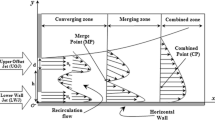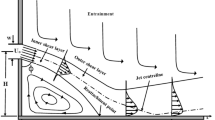Abstract
In the present case, the conjugate heat transfer involving a turbulent plane offset jet is considered. The bottom wall of the solid block is maintained at an isothermal temperature higher than the jet inlet temperature. The parameters considered are the offset ratio (OR), the conductivity ratio (K), the solid slab thickness (S) and the Prandtl number (Pr). The Reynolds number considered is 15,000 because the flow becomes fully turbulent and then it becomes independent of the Reynolds number. The ranges of parameters considered are: OR = 3, 7 and 11, K = 1–1,000, S = 1–10 and Pr = 0.01–100. High Reynolds number two-equation model (k–ε) has been used for turbulence modeling. Results for the solid–fluid interface temperature, local Nusselt number, local heat flux, average Nusselt number and average heat transfer have been presented and discussed.







Similar content being viewed by others
Abbreviations
- C p :
-
Specific heat at constant pressure
- Cε1, Cε2 and Cμ:
-
Turbulence model constants
- h :
-
Width of the jet
- H :
-
Offset height
- k :
-
Turbulent kinetic energy
- K :
-
Ratio of thermal conductivity of solid and fluid
- OR:
-
Offset ratio, H/h
- \( \overline{p} \) :
-
Static pressure
- p 0 :
-
Ambient pressure
- \( \overline{P} \) :
-
Non-dimensional static pressure
- Pr :
-
Prandtl number
- Re :
-
Reynolds number, U 0 h/ν
- \( \overline{T} \) :
-
Dimensional temperature
- T in :
-
Inlet temperature
- T ∞ :
-
Ambient temperature
- U 0 :
-
Average inlet jet velocity
- \( \overline{u}, \overline{v} \) :
-
Dimensional mean velocities in x, y-directions, respectively
- \( \overline{U}, \overline{V} \) :
-
Non-dimensional velocities in X, Y-directions, respectively
- x, y:
-
Dimensional co-ordinates
- X, Y:
-
Non-dimensional co-ordinates
- α, α t :
-
Laminar and turbulent thermal diffusivities, respectively
- ε :
-
Dissipation
- θ:
-
Non-dimensionalized temperature.
- ν, νt :
-
Laminar and turbulent kinematic viscosity
- ρ:
-
Density of fluid
- σ k , σε :
-
Turbulence model constants
- ΔT :
-
Reference temperature difference
References
Tritton DJ (1977) Physical fluid dynamics. Von Norstrand Reinhold, UK, pp 284–286
Hoch J, Jiji LM (1981) Two-dimensional turbulent offset jet-boundary interaction. Trans ASME J Fluids Eng 103:154–161
Hoch J, Jiji LM (1981) Theoretical and experimental temperature distribution in two dimensional turbulent jet-boundary interaction. Trans ASME J Heat Transf 103:331–335
Pelfrey JRR, Liburdy JA (1986) Mean flow characteristics of a turbulent offset jet. Trans ASME J Fluids Eng 108:82–88
Holland JT, Liburdy JA (1990) Measurements of the thermal characteristics of heated offset jets. Int J Heat Mass Transf 33(1):69–78
Kim DS, Yoon SH, Lee DH, Kim KC (1996) Flow and heat transfer measurements of a wall attaching offset jets. Int J Heat Mass Transf 39(14):2907–2913
Yoon SH, Eun SE, Chung MK (1988) Numerical study on the twodimensional stepped wall jet. Trans Korean Soc Mech Eng 12:865–875
Koo H-M, Park SO (1992) Prediction of turbulent offset jet flows with an assessment of QUICKER scheme. Int J Numer Methods Fluids 15:355–372
Nasr A, Lai JCR (1998) A turbulent plane offset jet with small offset ratio. Exp Fluids 24:47–57
Shuja SZ, Yilbas BS, Budair MO (1999) Gas jet impingement on a surface having a limited constant flux area: various turbulence models. Numer Heat Transf Part A 36(2):171–200
Kanna PR, Das MK (2005) Conjugate heat transfer study of two-dimensional laminar incompressible offset jet flows. Numer Heat Transf Part A 48(7):671–691
Kanna PR, Das MK (2006) Heat transfer study of two-dimensional laminar incompressible wall jet over backward-facing step. Numer Heat Transf Part A 50(2):165–187
Vishnuvardhanarao E, Das MK (2008) Computation of mean flow and thermal characteristics of incompressible turbulent offset jet flows. Numer Heat Transf Part A 53(8):843–869
Vishnuvardhanarao E, Das MK (2008) Computational study of heat transfer in a conjugate turbulent wall jet flow at high Reynolds number. Trans ASME J Heat Transf 130:072201-1-7
Vishnuvardhanarao E, Das MK (2009) Computational study of heat transfer in a conjugate turbulent wall jet flow with constant heat flux. Int J Numer Methods Heat Fluid Flow 19(1):39–52
Vishnuvardhanarao E, Das MK (2008) Study of conjugate heat transfer from a flat plate by turbulent offset jet flow. Numer Heat Transf Part A 53(5):524–542
Kanna PR, Das MK (2005) Conjugate forced convection heat transfer from a flat plate by laminar plane wall jet flow. Int J Heat Mass Transf 48(14):2896–2910
Iaccarino G, Ooi A, Durbin PA, Behnia M (2002) Conjugate heat transfer predictions in two-dimensional ribbed passages. Int J Heat Fluid Flow 23:340–345
Yilbas BS, Shuja SZ, Budair MO (2002) Jet impingement onto a cavity. Int J Numer Methods Heat Fluid Flow 12(7):817–838
Kassab A, Divo E, Heidmann J, Steinthorsson E, Rodriguez F (2003) Conjugate turbulent forced convection in a channel with an array of ribs. Int J Heat Fluid Flow 13:581–610
Hsieh KJ, Lien FS (2005) Conjugate turbulent forced convection in a channel with an array of ribs. Int J Heat Fluid Flow 15:462–482
Patankar SV (1980) Numerical heat transfer and fluid flow. Hemisphere, New York
Launder BE, Spalding DB (1974) The numerical computation of turbulent flows. Comput Methods Appl Mech Eng 3:269–289
Versteeg HK, Malalasekera W (1996) An introduction to computational fluid dynamics. The finite volume method. Longman, London
Author information
Authors and Affiliations
Corresponding author
Appendix
Appendix
1.1 Deriving the expression for heat flux in the fluid side
At the interface between the solid and fluid, the following conditions are applied.
-
θ s = θ f at the interface.
-
Heat transfer across the interface must be equal.
Wall heat flux in the fluid side is given by:
where P f pee-function, which is given by:
Wall heat flux in the solid side is given by:
Interface temperature is calculated by equating Eqs. 11 and 13. Where θp,f, θp,s are neighbor temperatures in the fluid and solid regions.
1.2 Deriving the expression for Nusselt number calculation
We can write the above equation as:
Finally,
We can write the above equation as:
Finally,
Since θ∞ = 0. Which is used for calculating the Local Nusselt number distribution. The average Nusselt number is calculated as:
Rights and permissions
About this article
Cite this article
Vishnuvardhanarao, E., Das, M.K. Conjugate heat transfer study of incompressible turbulent offset jet flows. Heat Mass Transfer 45, 1141–1152 (2009). https://doi.org/10.1007/s00231-009-0486-9
Received:
Accepted:
Published:
Issue Date:
DOI: https://doi.org/10.1007/s00231-009-0486-9




